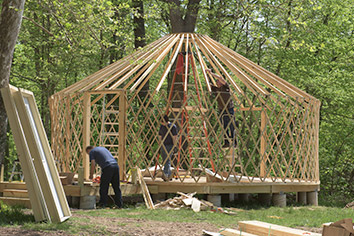Subscriber Benefit
As a subscriber you can listen to articles at work, in the car, or while you work out. Subscribe NowYurts have been a form of shelter for more than 2,000 years. But Indianapolis-based Yurts of America—one of the nation’s largest makers of the round, tent-like structures—today builds them with materials that didn’t even exist back then.
The original materials—horsehide and goat felt—might sound romantic. But they offer none of the durability of the materials the company has begun using in recent years, such as Gore-Tex thread.
“When people look at a yurt, they think of natural products,” said Jerry Ritchie, a Yurts of America co-owner. “But nothing [in a yurt] is a natural product because it falls apart.”
Yurts of America has been producing yurts for 29 years, the last nine from a warehouse near Interstate 465 and Pendleton Pike that employs about 10 people.
The latest innovations to hit the yurt market might seem quite technical but are important, nonetheless. The Gore-Tex thread, for instance, replaced the polyester twill that’s used in boat covers.
Gore-Tex, a trademarked type of Teflon from Newark, Delaware-based W.L. Gore and Associates, “lasts forever, basically,” Ritchie said.
Another advancement is the use of cellular acrylic to produce skylight domes that has proven to be sturdier than the type of acrylic it replaced.
“You’d be surprised at the different materials that are available,” Ritchie said, after concluding a phone call with a potential customer in which he quoted him a yurt price of $14,000.
Yurts of America offers models ranging in size from 16 feet to 30 feet and priced from $6,000 to $20,000, based on how a buyer wants the yurt equipped. The company simply supplies the structure; how customers want to outfit it—some even with plumbing for a kitchen and bathroom—depends on how much more they want to spend.
Prices have remained steady mainly because of intense competition, Ritchie said. Yurts of America is one of the top three yurt firms in the country—Oregon-based Pacific Yurts and Colorado-based Colorado Yurt Co. are the other two. And then there are folks making yurts out of their garages.
Yurts of America would not disclose revenue but said it has increased 30 percent since 2014. The company exports to Canada, Europe and Central America, said Ritchie, noting that the sometimes-controversial North American Free Trade Agreement has been “great for us.”
Ritchie attributes much of the spike in business to an increase in travel.
“People find them interesting,” he said, but not necessarily cheaper than a cabin. “They have all the exoticism of a faraway place.”
Yurts of America sews the materials and cuts the wood used in making yurts but doesn’t assemble them. Installation kits are available.
The company ships eight to 10 yurts a month.
Ritchie said Yurts of America might begin offering a 16-foot model with a utilities kit in an attempt to crack more of the tiny-house market, which advocates simple living in tiny homes.
For now, Yurts of America sees about 80 percent of its business from not-for-profit camps, resorts and recreational-vehicle parks.
One of those is the Flat Rock River YMCA Camp in St. Paul, south of Shelbyville.
The camp on May 6 assembled two, 24-foot yurts it recently purchased from the company, bringing its yurt total to 10. The yurts can sleep up to 12 campers each.
Flat Rock has cabins on the grounds but leans toward yurts, said Don Sheppard, the camp’s executive director.
“They allow a lot of natural light, and they’re a really cost-effective way for us to serve young people with an outstanding camp experience,” he said. “And lastly, the circular design fits well with what we’re trying to do to help children form friendships and communications.”
Ken Lawrence founded the company nearly 30 years ago and remains a co-owner. He sold a handful of yurts on the side until he lost his computer job after 9/11 and started making them full time.
A lot has changed in the yurt-making business, even since then.
“If you take care of it, it should last indefinitely,” Ritchie said, “just like your house.”•
Please enable JavaScript to view this content.

